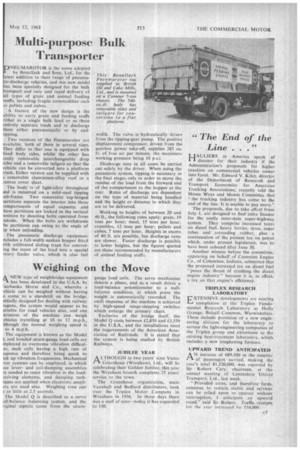Multi-purpose Bulk Transporter
Page 41

If you've noticed an error in this article please click here to report it so we can fix it.
NEUMAROTOR is the name adopted by Bona!lack and Sons, Ltd., for the atest addition to their range of pneuma'e-discharge vehicles, and this new model as been specially designed for the bulk ransport and easy and rapid delivery of all types of grain and animal feeding stuffs, including fragile commodities such as pellets and cubes.
A feature of the new design is the ability to carry grain and feeding stuffs either as a single bulk load or as three entirely separate loads and to discharge them either pneumatically or by endtipping.
Two versions of the Pneumarotor are available, both of them in several sizes. They 'differ in that one is equipped with fixed body sides, whilst the other has easily removable interchangeable drop sides and a removable tailgate so that the vehicle can be converted into a platform truck.. Either version can be supplied with
removable aluminium-alloy -roof or a ...anvas cover sheet.
The body is of light-alloy throughout Ind is mounted on a mild-steel tipping tub-frame. Two removable top-hinged 3artitions separate the interior into three :ompartments of equal capacity, and hese partitions are locked in the vertical losition by shooting bolts operated from 3utside. When the bolts are withdrawn he partitions can swing to the angle of ip when unloading.
The pneumatic discharge equipment ncIudes a full-width sunken hopper fitted vith calibrated sliding traps for controling the input of the load into a special .otary feeder valve, which is also full
width. The valve is hydraulically driven from the tipping-gear pump. The positive displacement compressor, driven from the gearbox power take-off. sup'plies 285 Cu. ft. of free air per minute, the maximum working pressure being 10 p.s.i.
Discharge may in all cases be carried out solely by the driver. When using the pneumatic system, tipping is necessary in the final stages only in order to move the residue of the load from the forward end of the compartment to the hopper at the rear. Rates of discharge are dependent on the type of material being handled and the height or distance to which they are to be delivered.
Working to heights of between 20 and 40 ft., the following rates apply: grain, 19 tons per hour; meal, 15 tons per hour; crumbles, 12 tons per hour; pellets and cubes, 7 tons per hour. Heights in excess of 40 ft. are possible, but discharge rates are slower. Faster discharge is possible to lower heights, but the figures quoted are those recommended by manufacturers of animal feeding stuffs.
























































































































